Literature Review: Alcohol Marketing's Influence on Youth in the USA
VerifiedAdded on 2022/08/27
|7
|1940
|14
Literature Review
AI Summary
This literature review investigates the effects of alcohol marketing strategies on youth alcohol consumption in the United States. The study explores the impact of various marketing techniques, including social media campaigns, sponsorships, and advertisements, on underage drinking patterns. It examines how the Segmentation, Targeting, and Positioning (STP) model, Contingency Theory, Theory of Planned Behavior, and Drive Theory of Motivation can explain the alcohol industry's approach to target youth. The review analyzes several studies, including those focusing on brand-specific advertising exposure, the role of television and social media, and the psychological mechanisms driving youth to follow trends and imitate celebrities. The research questions address the extent to which marketing strategies influence underage consumption, ethical and social responsibility issues, and potential control measures to mitigate the impact of marketing on youth alcohol consumption. The review references key academic papers and journals to support its findings.

Running head: ALCOHOL MARKETING AND ITS EFFECT ON YOUTH
ALCOHOL MARKETING AND ITS EFFECT ON YOUTH
Name of the student
Name of the University
Author note
ALCOHOL MARKETING AND ITS EFFECT ON YOUTH
Name of the student
Name of the University
Author note
Paraphrase This Document
Need a fresh take? Get an instant paraphrase of this document with our AI Paraphraser
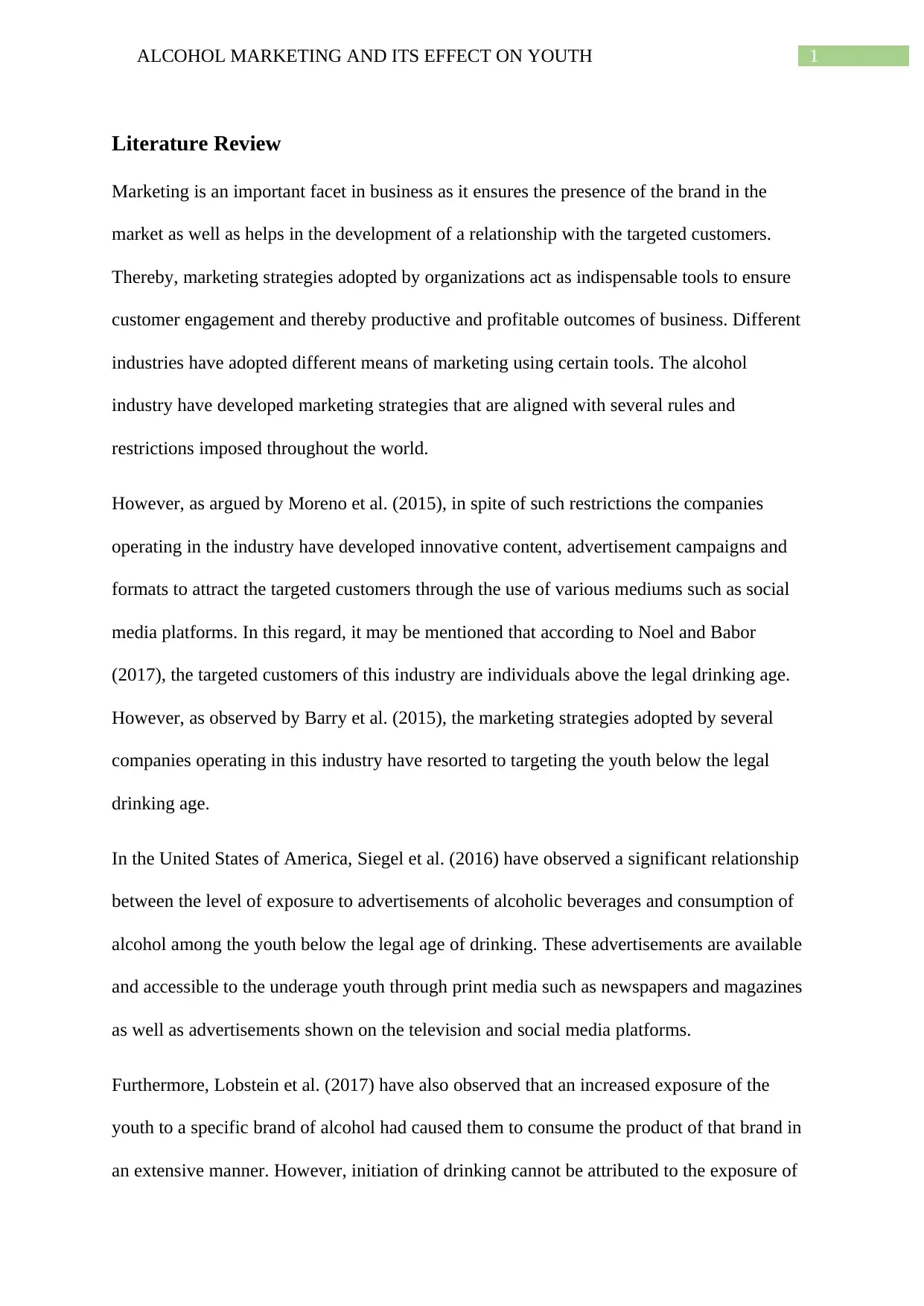
1ALCOHOL MARKETING AND ITS EFFECT ON YOUTH
Literature Review
Marketing is an important facet in business as it ensures the presence of the brand in the
market as well as helps in the development of a relationship with the targeted customers.
Thereby, marketing strategies adopted by organizations act as indispensable tools to ensure
customer engagement and thereby productive and profitable outcomes of business. Different
industries have adopted different means of marketing using certain tools. The alcohol
industry have developed marketing strategies that are aligned with several rules and
restrictions imposed throughout the world.
However, as argued by Moreno et al. (2015), in spite of such restrictions the companies
operating in the industry have developed innovative content, advertisement campaigns and
formats to attract the targeted customers through the use of various mediums such as social
media platforms. In this regard, it may be mentioned that according to Noel and Babor
(2017), the targeted customers of this industry are individuals above the legal drinking age.
However, as observed by Barry et al. (2015), the marketing strategies adopted by several
companies operating in this industry have resorted to targeting the youth below the legal
drinking age.
In the United States of America, Siegel et al. (2016) have observed a significant relationship
between the level of exposure to advertisements of alcoholic beverages and consumption of
alcohol among the youth below the legal age of drinking. These advertisements are available
and accessible to the underage youth through print media such as newspapers and magazines
as well as advertisements shown on the television and social media platforms.
Furthermore, Lobstein et al. (2017) have also observed that an increased exposure of the
youth to a specific brand of alcohol had caused them to consume the product of that brand in
an extensive manner. However, initiation of drinking cannot be attributed to the exposure of
Literature Review
Marketing is an important facet in business as it ensures the presence of the brand in the
market as well as helps in the development of a relationship with the targeted customers.
Thereby, marketing strategies adopted by organizations act as indispensable tools to ensure
customer engagement and thereby productive and profitable outcomes of business. Different
industries have adopted different means of marketing using certain tools. The alcohol
industry have developed marketing strategies that are aligned with several rules and
restrictions imposed throughout the world.
However, as argued by Moreno et al. (2015), in spite of such restrictions the companies
operating in the industry have developed innovative content, advertisement campaigns and
formats to attract the targeted customers through the use of various mediums such as social
media platforms. In this regard, it may be mentioned that according to Noel and Babor
(2017), the targeted customers of this industry are individuals above the legal drinking age.
However, as observed by Barry et al. (2015), the marketing strategies adopted by several
companies operating in this industry have resorted to targeting the youth below the legal
drinking age.
In the United States of America, Siegel et al. (2016) have observed a significant relationship
between the level of exposure to advertisements of alcoholic beverages and consumption of
alcohol among the youth below the legal age of drinking. These advertisements are available
and accessible to the underage youth through print media such as newspapers and magazines
as well as advertisements shown on the television and social media platforms.
Furthermore, Lobstein et al. (2017) have also observed that an increased exposure of the
youth to a specific brand of alcohol had caused them to consume the product of that brand in
an extensive manner. However, initiation of drinking cannot be attributed to the exposure of

2ALCOHOL MARKETING AND ITS EFFECT ON YOUTH
the underage youth to these advertisements and other marketing strategies adopted by the
various alcohol brands.
The opinion of Ross et al. (2015), regarding the relationship between exposure of alcohol
advertisements and consumption of alcohol by underage youth in the United States of
America has shown similar results as that of Siegel et al. (2016). In this regard, it may be
mentioned that the marketing strategies adopted by the companies operating in the alcohol
industry have had a huge impact on the patterns of alcohol consumption by the youth in the
country.
Identifiably, there are certain strategies that are adopted by the alcohol companies to widen
their customer base to include the underage youth. According to Jernigan et al. (2017), these
strategies include sponsorships in events that attract the youth, attractive advertisement
campaigns and promotions of beverages with low alcohol content. These strategies have been
effective in attracting the attention of the youth, thereby increasing their probability to
commence alcohol consumption from a young age.
Furthermore, the social media plays an important role in helping the alcohol companies to
target underage youth such as high school and college students effectively. As argued by
Boyle et al. (2016), the youth such as college students from the first year are often attracted
towards risky drinking and have glamorized the act as being popular. Posts on the social
media websites have further aided the reconstruction of the negative consequences of
underage alcohol consumption, denoting the psychological mechanism among the youth to
follow popular trends.
Another argument proposed by Ross et al. (2015), reiterates the role of alcohol marketing
through television in determining the rate of alcohol consumption in the youth of the United
States of America. The psychological mechanism of following popular trends among the
the underage youth to these advertisements and other marketing strategies adopted by the
various alcohol brands.
The opinion of Ross et al. (2015), regarding the relationship between exposure of alcohol
advertisements and consumption of alcohol by underage youth in the United States of
America has shown similar results as that of Siegel et al. (2016). In this regard, it may be
mentioned that the marketing strategies adopted by the companies operating in the alcohol
industry have had a huge impact on the patterns of alcohol consumption by the youth in the
country.
Identifiably, there are certain strategies that are adopted by the alcohol companies to widen
their customer base to include the underage youth. According to Jernigan et al. (2017), these
strategies include sponsorships in events that attract the youth, attractive advertisement
campaigns and promotions of beverages with low alcohol content. These strategies have been
effective in attracting the attention of the youth, thereby increasing their probability to
commence alcohol consumption from a young age.
Furthermore, the social media plays an important role in helping the alcohol companies to
target underage youth such as high school and college students effectively. As argued by
Boyle et al. (2016), the youth such as college students from the first year are often attracted
towards risky drinking and have glamorized the act as being popular. Posts on the social
media websites have further aided the reconstruction of the negative consequences of
underage alcohol consumption, denoting the psychological mechanism among the youth to
follow popular trends.
Another argument proposed by Ross et al. (2015), reiterates the role of alcohol marketing
through television in determining the rate of alcohol consumption in the youth of the United
States of America. The psychological mechanism of following popular trends among the
⊘ This is a preview!⊘
Do you want full access?
Subscribe today to unlock all pages.

Trusted by 1+ million students worldwide
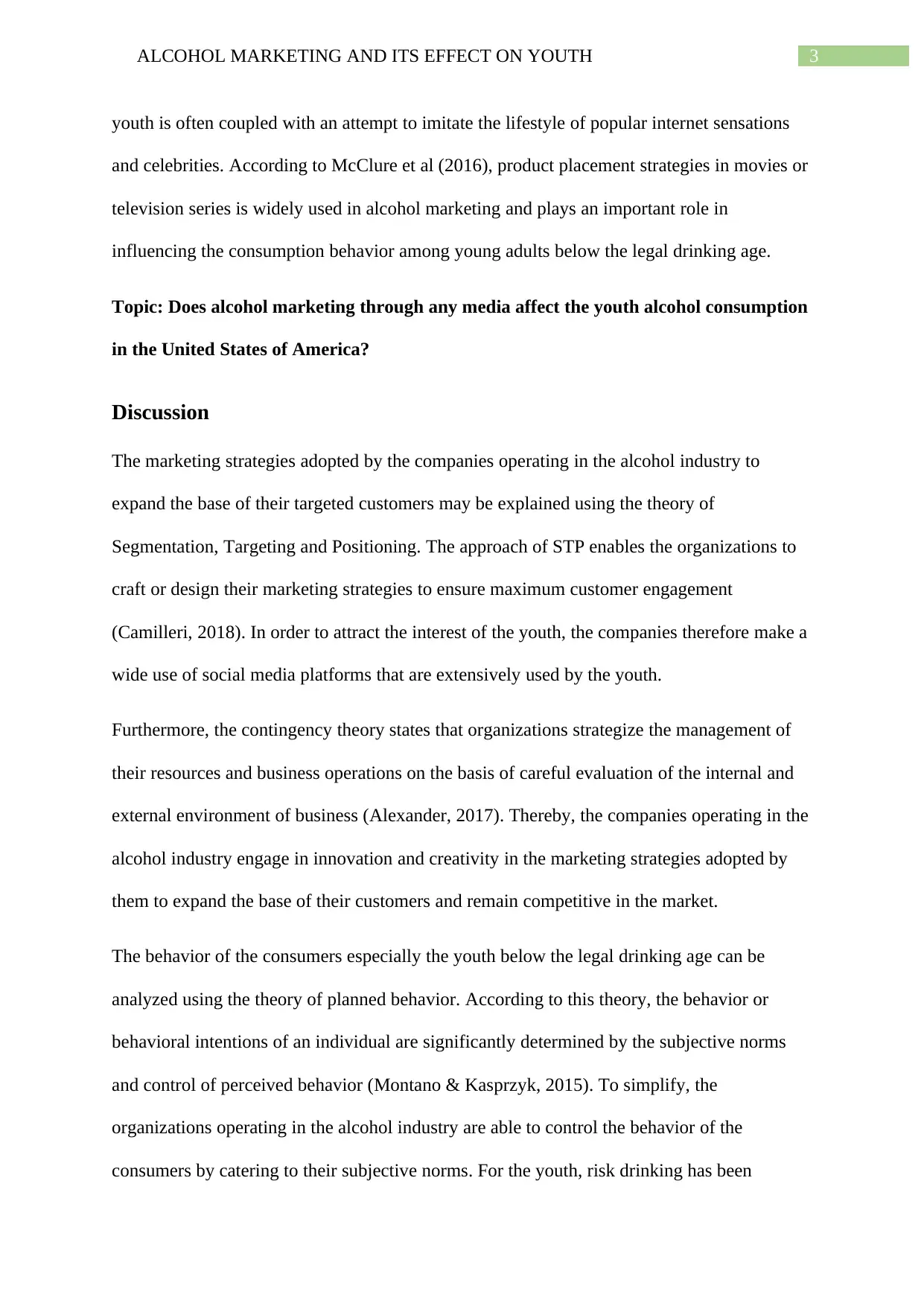
3ALCOHOL MARKETING AND ITS EFFECT ON YOUTH
youth is often coupled with an attempt to imitate the lifestyle of popular internet sensations
and celebrities. According to McClure et al (2016), product placement strategies in movies or
television series is widely used in alcohol marketing and plays an important role in
influencing the consumption behavior among young adults below the legal drinking age.
Topic: Does alcohol marketing through any media affect the youth alcohol consumption
in the United States of America?
Discussion
The marketing strategies adopted by the companies operating in the alcohol industry to
expand the base of their targeted customers may be explained using the theory of
Segmentation, Targeting and Positioning. The approach of STP enables the organizations to
craft or design their marketing strategies to ensure maximum customer engagement
(Camilleri, 2018). In order to attract the interest of the youth, the companies therefore make a
wide use of social media platforms that are extensively used by the youth.
Furthermore, the contingency theory states that organizations strategize the management of
their resources and business operations on the basis of careful evaluation of the internal and
external environment of business (Alexander, 2017). Thereby, the companies operating in the
alcohol industry engage in innovation and creativity in the marketing strategies adopted by
them to expand the base of their customers and remain competitive in the market.
The behavior of the consumers especially the youth below the legal drinking age can be
analyzed using the theory of planned behavior. According to this theory, the behavior or
behavioral intentions of an individual are significantly determined by the subjective norms
and control of perceived behavior (Montano & Kasprzyk, 2015). To simplify, the
organizations operating in the alcohol industry are able to control the behavior of the
consumers by catering to their subjective norms. For the youth, risk drinking has been
youth is often coupled with an attempt to imitate the lifestyle of popular internet sensations
and celebrities. According to McClure et al (2016), product placement strategies in movies or
television series is widely used in alcohol marketing and plays an important role in
influencing the consumption behavior among young adults below the legal drinking age.
Topic: Does alcohol marketing through any media affect the youth alcohol consumption
in the United States of America?
Discussion
The marketing strategies adopted by the companies operating in the alcohol industry to
expand the base of their targeted customers may be explained using the theory of
Segmentation, Targeting and Positioning. The approach of STP enables the organizations to
craft or design their marketing strategies to ensure maximum customer engagement
(Camilleri, 2018). In order to attract the interest of the youth, the companies therefore make a
wide use of social media platforms that are extensively used by the youth.
Furthermore, the contingency theory states that organizations strategize the management of
their resources and business operations on the basis of careful evaluation of the internal and
external environment of business (Alexander, 2017). Thereby, the companies operating in the
alcohol industry engage in innovation and creativity in the marketing strategies adopted by
them to expand the base of their customers and remain competitive in the market.
The behavior of the consumers especially the youth below the legal drinking age can be
analyzed using the theory of planned behavior. According to this theory, the behavior or
behavioral intentions of an individual are significantly determined by the subjective norms
and control of perceived behavior (Montano & Kasprzyk, 2015). To simplify, the
organizations operating in the alcohol industry are able to control the behavior of the
consumers by catering to their subjective norms. For the youth, risk drinking has been
Paraphrase This Document
Need a fresh take? Get an instant paraphrase of this document with our AI Paraphraser
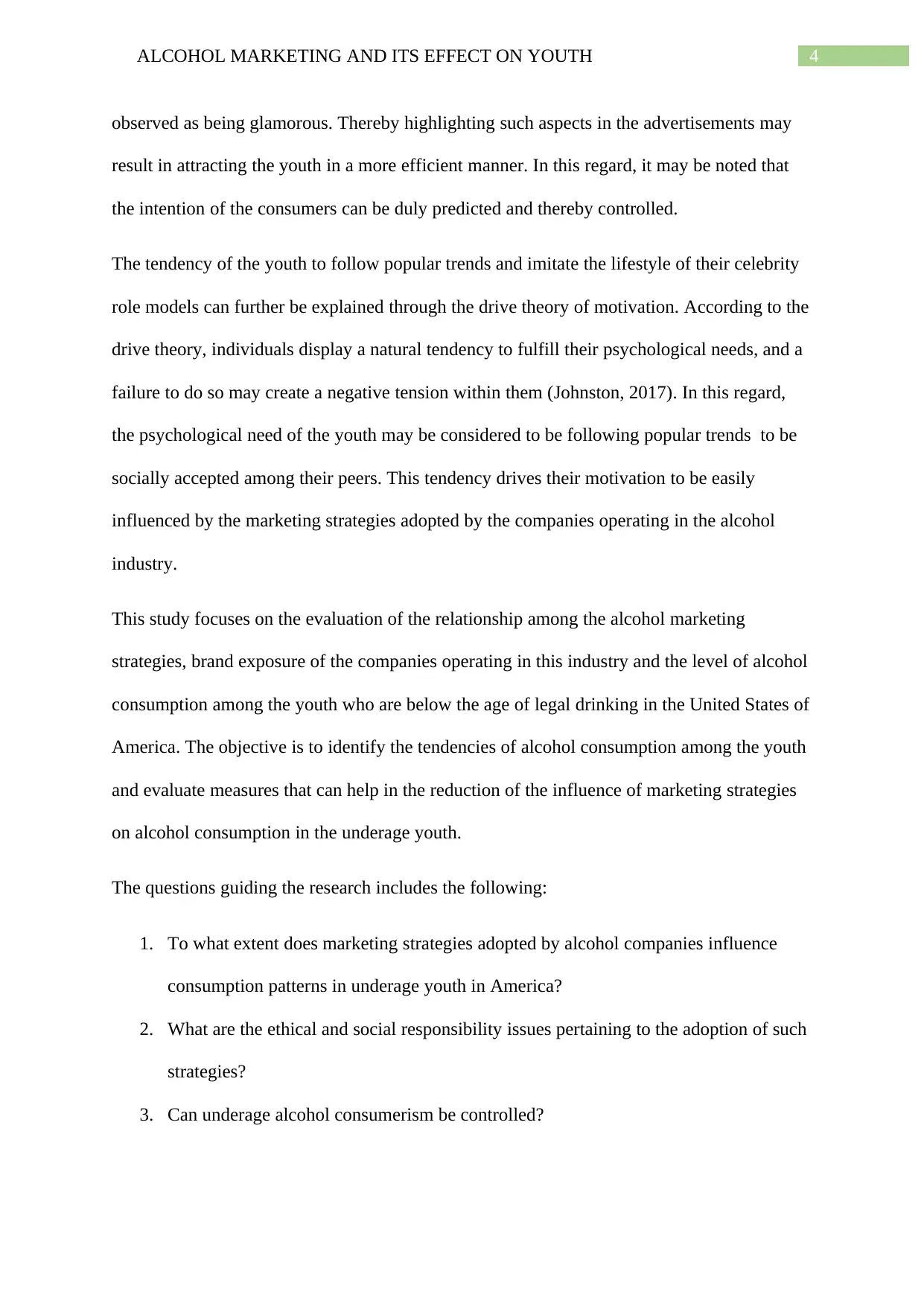
4ALCOHOL MARKETING AND ITS EFFECT ON YOUTH
observed as being glamorous. Thereby highlighting such aspects in the advertisements may
result in attracting the youth in a more efficient manner. In this regard, it may be noted that
the intention of the consumers can be duly predicted and thereby controlled.
The tendency of the youth to follow popular trends and imitate the lifestyle of their celebrity
role models can further be explained through the drive theory of motivation. According to the
drive theory, individuals display a natural tendency to fulfill their psychological needs, and a
failure to do so may create a negative tension within them (Johnston, 2017). In this regard,
the psychological need of the youth may be considered to be following popular trends to be
socially accepted among their peers. This tendency drives their motivation to be easily
influenced by the marketing strategies adopted by the companies operating in the alcohol
industry.
This study focuses on the evaluation of the relationship among the alcohol marketing
strategies, brand exposure of the companies operating in this industry and the level of alcohol
consumption among the youth who are below the age of legal drinking in the United States of
America. The objective is to identify the tendencies of alcohol consumption among the youth
and evaluate measures that can help in the reduction of the influence of marketing strategies
on alcohol consumption in the underage youth.
The questions guiding the research includes the following:
1. To what extent does marketing strategies adopted by alcohol companies influence
consumption patterns in underage youth in America?
2. What are the ethical and social responsibility issues pertaining to the adoption of such
strategies?
3. Can underage alcohol consumerism be controlled?
observed as being glamorous. Thereby highlighting such aspects in the advertisements may
result in attracting the youth in a more efficient manner. In this regard, it may be noted that
the intention of the consumers can be duly predicted and thereby controlled.
The tendency of the youth to follow popular trends and imitate the lifestyle of their celebrity
role models can further be explained through the drive theory of motivation. According to the
drive theory, individuals display a natural tendency to fulfill their psychological needs, and a
failure to do so may create a negative tension within them (Johnston, 2017). In this regard,
the psychological need of the youth may be considered to be following popular trends to be
socially accepted among their peers. This tendency drives their motivation to be easily
influenced by the marketing strategies adopted by the companies operating in the alcohol
industry.
This study focuses on the evaluation of the relationship among the alcohol marketing
strategies, brand exposure of the companies operating in this industry and the level of alcohol
consumption among the youth who are below the age of legal drinking in the United States of
America. The objective is to identify the tendencies of alcohol consumption among the youth
and evaluate measures that can help in the reduction of the influence of marketing strategies
on alcohol consumption in the underage youth.
The questions guiding the research includes the following:
1. To what extent does marketing strategies adopted by alcohol companies influence
consumption patterns in underage youth in America?
2. What are the ethical and social responsibility issues pertaining to the adoption of such
strategies?
3. Can underage alcohol consumerism be controlled?
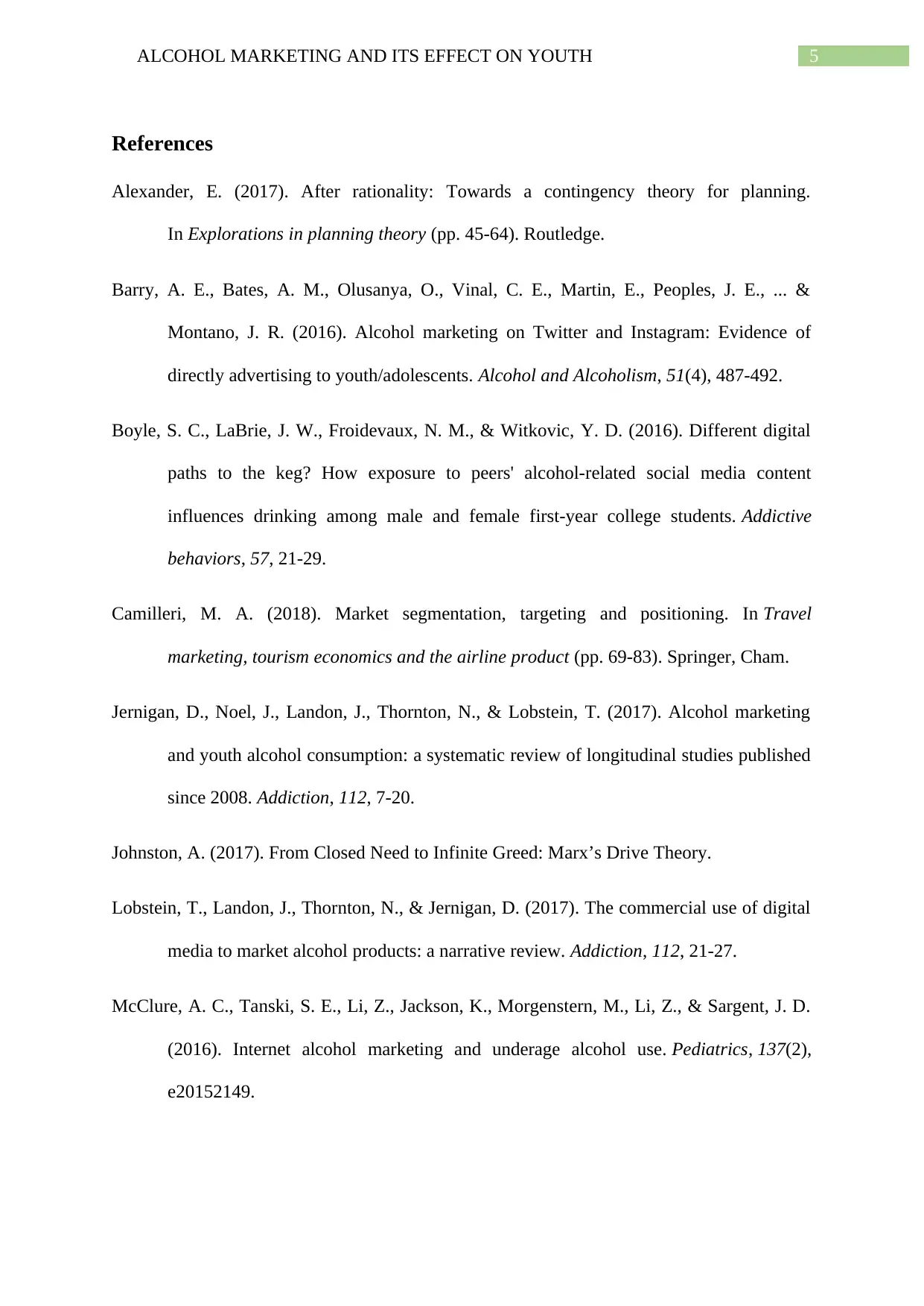
5ALCOHOL MARKETING AND ITS EFFECT ON YOUTH
References
Alexander, E. (2017). After rationality: Towards a contingency theory for planning.
In Explorations in planning theory (pp. 45-64). Routledge.
Barry, A. E., Bates, A. M., Olusanya, O., Vinal, C. E., Martin, E., Peoples, J. E., ... &
Montano, J. R. (2016). Alcohol marketing on Twitter and Instagram: Evidence of
directly advertising to youth/adolescents. Alcohol and Alcoholism, 51(4), 487-492.
Boyle, S. C., LaBrie, J. W., Froidevaux, N. M., & Witkovic, Y. D. (2016). Different digital
paths to the keg? How exposure to peers' alcohol-related social media content
influences drinking among male and female first-year college students. Addictive
behaviors, 57, 21-29.
Camilleri, M. A. (2018). Market segmentation, targeting and positioning. In Travel
marketing, tourism economics and the airline product (pp. 69-83). Springer, Cham.
Jernigan, D., Noel, J., Landon, J., Thornton, N., & Lobstein, T. (2017). Alcohol marketing
and youth alcohol consumption: a systematic review of longitudinal studies published
since 2008. Addiction, 112, 7-20.
Johnston, A. (2017). From Closed Need to Infinite Greed: Marx’s Drive Theory.
Lobstein, T., Landon, J., Thornton, N., & Jernigan, D. (2017). The commercial use of digital
media to market alcohol products: a narrative review. Addiction, 112, 21-27.
McClure, A. C., Tanski, S. E., Li, Z., Jackson, K., Morgenstern, M., Li, Z., & Sargent, J. D.
(2016). Internet alcohol marketing and underage alcohol use. Pediatrics, 137(2),
e20152149.
References
Alexander, E. (2017). After rationality: Towards a contingency theory for planning.
In Explorations in planning theory (pp. 45-64). Routledge.
Barry, A. E., Bates, A. M., Olusanya, O., Vinal, C. E., Martin, E., Peoples, J. E., ... &
Montano, J. R. (2016). Alcohol marketing on Twitter and Instagram: Evidence of
directly advertising to youth/adolescents. Alcohol and Alcoholism, 51(4), 487-492.
Boyle, S. C., LaBrie, J. W., Froidevaux, N. M., & Witkovic, Y. D. (2016). Different digital
paths to the keg? How exposure to peers' alcohol-related social media content
influences drinking among male and female first-year college students. Addictive
behaviors, 57, 21-29.
Camilleri, M. A. (2018). Market segmentation, targeting and positioning. In Travel
marketing, tourism economics and the airline product (pp. 69-83). Springer, Cham.
Jernigan, D., Noel, J., Landon, J., Thornton, N., & Lobstein, T. (2017). Alcohol marketing
and youth alcohol consumption: a systematic review of longitudinal studies published
since 2008. Addiction, 112, 7-20.
Johnston, A. (2017). From Closed Need to Infinite Greed: Marx’s Drive Theory.
Lobstein, T., Landon, J., Thornton, N., & Jernigan, D. (2017). The commercial use of digital
media to market alcohol products: a narrative review. Addiction, 112, 21-27.
McClure, A. C., Tanski, S. E., Li, Z., Jackson, K., Morgenstern, M., Li, Z., & Sargent, J. D.
(2016). Internet alcohol marketing and underage alcohol use. Pediatrics, 137(2),
e20152149.
⊘ This is a preview!⊘
Do you want full access?
Subscribe today to unlock all pages.

Trusted by 1+ million students worldwide
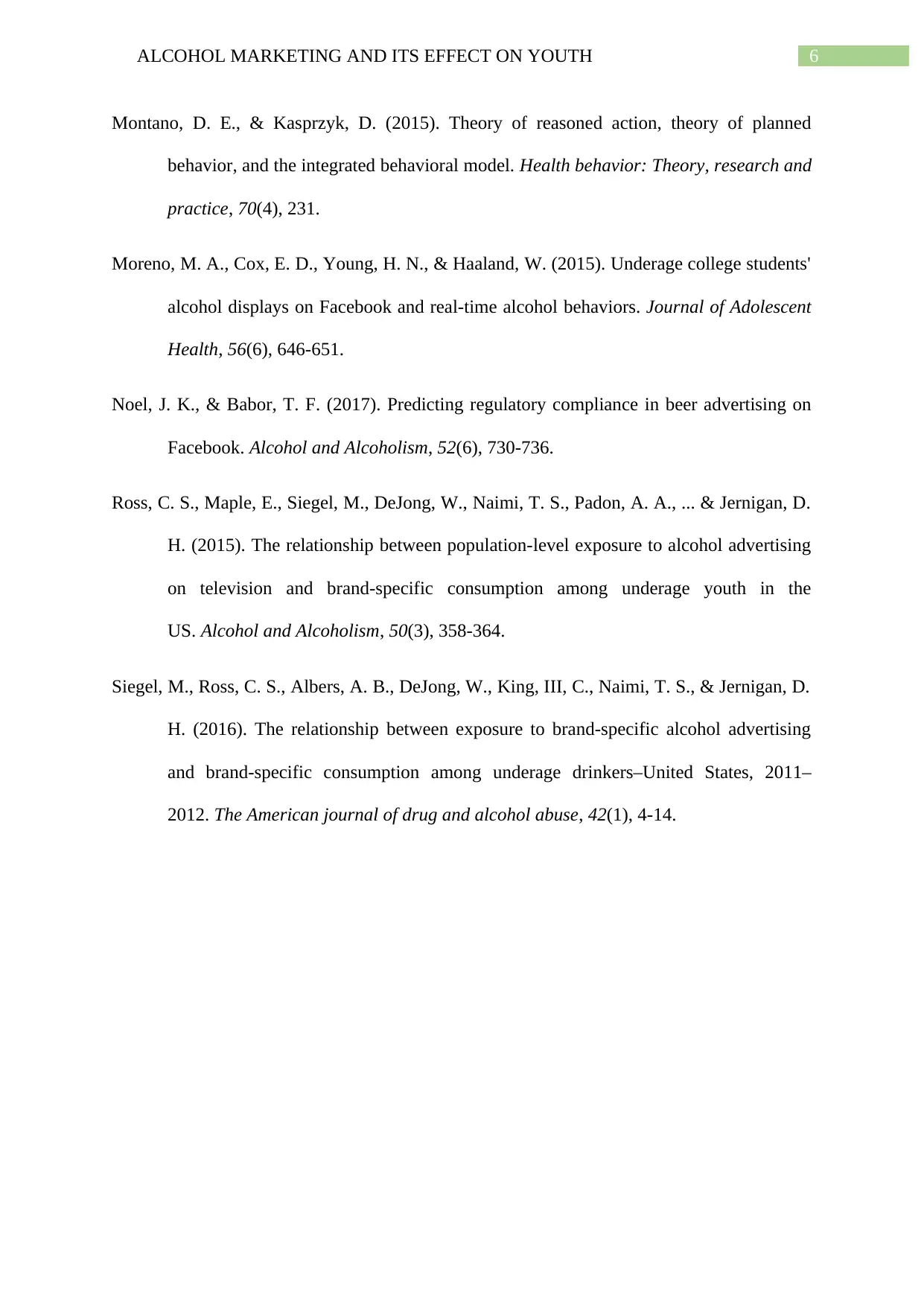
6ALCOHOL MARKETING AND ITS EFFECT ON YOUTH
Montano, D. E., & Kasprzyk, D. (2015). Theory of reasoned action, theory of planned
behavior, and the integrated behavioral model. Health behavior: Theory, research and
practice, 70(4), 231.
Moreno, M. A., Cox, E. D., Young, H. N., & Haaland, W. (2015). Underage college students'
alcohol displays on Facebook and real-time alcohol behaviors. Journal of Adolescent
Health, 56(6), 646-651.
Noel, J. K., & Babor, T. F. (2017). Predicting regulatory compliance in beer advertising on
Facebook. Alcohol and Alcoholism, 52(6), 730-736.
Ross, C. S., Maple, E., Siegel, M., DeJong, W., Naimi, T. S., Padon, A. A., ... & Jernigan, D.
H. (2015). The relationship between population-level exposure to alcohol advertising
on television and brand-specific consumption among underage youth in the
US. Alcohol and Alcoholism, 50(3), 358-364.
Siegel, M., Ross, C. S., Albers, A. B., DeJong, W., King, III, C., Naimi, T. S., & Jernigan, D.
H. (2016). The relationship between exposure to brand-specific alcohol advertising
and brand-specific consumption among underage drinkers–United States, 2011–
2012. The American journal of drug and alcohol abuse, 42(1), 4-14.
Montano, D. E., & Kasprzyk, D. (2015). Theory of reasoned action, theory of planned
behavior, and the integrated behavioral model. Health behavior: Theory, research and
practice, 70(4), 231.
Moreno, M. A., Cox, E. D., Young, H. N., & Haaland, W. (2015). Underage college students'
alcohol displays on Facebook and real-time alcohol behaviors. Journal of Adolescent
Health, 56(6), 646-651.
Noel, J. K., & Babor, T. F. (2017). Predicting regulatory compliance in beer advertising on
Facebook. Alcohol and Alcoholism, 52(6), 730-736.
Ross, C. S., Maple, E., Siegel, M., DeJong, W., Naimi, T. S., Padon, A. A., ... & Jernigan, D.
H. (2015). The relationship between population-level exposure to alcohol advertising
on television and brand-specific consumption among underage youth in the
US. Alcohol and Alcoholism, 50(3), 358-364.
Siegel, M., Ross, C. S., Albers, A. B., DeJong, W., King, III, C., Naimi, T. S., & Jernigan, D.
H. (2016). The relationship between exposure to brand-specific alcohol advertising
and brand-specific consumption among underage drinkers–United States, 2011–
2012. The American journal of drug and alcohol abuse, 42(1), 4-14.
1 out of 7
Related Documents
Your All-in-One AI-Powered Toolkit for Academic Success.
+13062052269
info@desklib.com
Available 24*7 on WhatsApp / Email
![[object Object]](/_next/static/media/star-bottom.7253800d.svg)
Unlock your academic potential
Copyright © 2020–2025 A2Z Services. All Rights Reserved. Developed and managed by ZUCOL.





